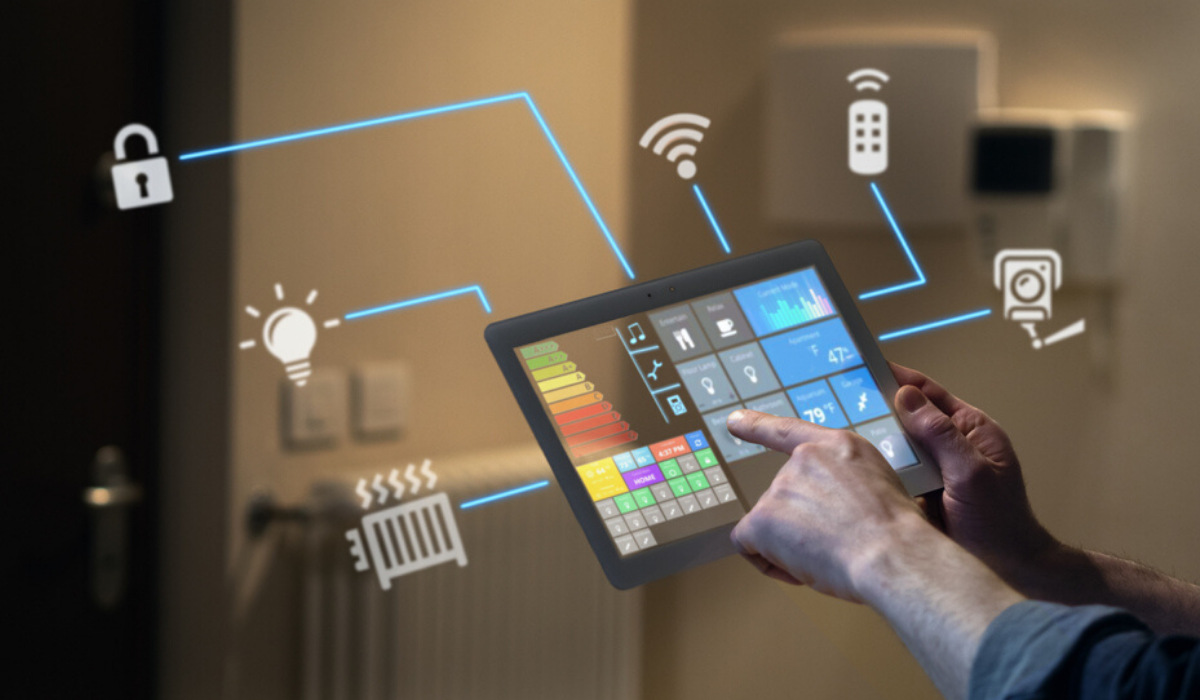In today’s fast-paced world, where technology is deeply interwoven into the fabric of our daily lives, smart home gadgets have emerged as a transformative force in how we live, work, and interact with our environment. From automating mundane tasks to enhancing security and energy efficiency, these innovative devices are redefining our understanding of comfort and convenience in the modern home.
Smart home gadgets

The realm of smart home gadgets is vast and diverse, encompassing everything from simple Wi-Fi-enabled light bulbs to sophisticated home automation systems. These devices promise to streamline our routines and elevate our quality of life. In this section, we will explore the key aspects of smart home gadgets, examining their benefits, functionalities, and the future trends that shape this exciting landscape.
What Are Smart Home Gadgets?
Smart home gadgets refer to electronic devices that connect to a network, allowing users to control and monitor them remotely. These gadgets communicate through various protocols, such as Wi-Fi, Zigbee, or Bluetooth, enabling seamless integration within the home ecosystem.
The core purpose of these devices is to enhance everyday living by providing automation, convenience, and improved efficiency. For instance, smart thermostats can learn your heating and cooling preferences over time, adjusting temperatures accordingly to optimize energy usage. Similarly, smart speakers can control multiple devices via voice commands, making it easier than ever to manage your household.
As technology continues to advance, smart home gadgets are becoming increasingly sophisticated. Many now come equipped with artificial intelligence capabilities, allowing them to learn and adapt to user behavior. This development opens a world of possibilities for customization and personalization, ensuring that your home feels uniquely tailored to you.
Benefits of Smart Home Gadgets
One of the most compelling reasons homeowners gravitate toward smart home gadgets is the multitude of benefits they offer. These devices not only enhance convenience but also promote safety, energy efficiency, and lifestyle improvement.
Convenience: Imagine walking into your home and having the lights turn on automatically, your favorite playlist start playing, and the thermostat adjust to your preferred temperature—all without lifting a finger. Smart home gadgets allow for effortless control and automation, simplifying day-to-day activities.
Safety and Security: Enhanced security features are another significant advantage of smart home gadgets. With smart cameras, doorbells, and locks, homeowners can monitor their property from anywhere in the world. Alerts can be sent directly to your smartphone if any unusual activity is detected, providing peace of mind, especially when you’re away from home.
Energy Efficiency: Many smart home gadgets are designed with energy conservation in mind. Devices like smart thermostats can significantly reduce energy consumption by adapting heating and cooling schedules based on your habits. Lighting systems can automatically dim or turn off based on occupancy, minimizing waste.
Challenges and Considerations
Despite the numerous benefits associated with smart home gadgets, potential challenges must also be considered. The integration of technology into our homes raises questions about security, privacy, and compatibility.
Security Risks: As more devices become interconnected, the risk of cyberattacks increases. Poorly secured devices can be exploited by hackers, potentially compromising personal information or granting unauthorized access to your home. It is crucial for homeowners to educate themselves about the security measures available and to choose reputable brands that prioritize cybersecurity.
Privacy Concerns: Many smart home gadgets collect data, which can raise privacy concerns. Understanding what data is being collected, how it is used, and who has access to it is vital. Homeowners should review privacy policies and make informed decisions about the devices they adopt.
Compatibility Issues: Not all smart home gadgets work seamlessly together. When building a smart home ecosystem, compatibility between devices can be a significant concern. Homeowners must carefully research and select gadgets that can communicate effectively, ideally using common platforms or standards.
The Future of Smart Home Gadgets
The future of smart home gadgets is bright, with innovations on the horizon that promise to transform our living spaces even further. Emerging technologies such as the Internet of Things (IoT), machine learning, and 5G connectivity will drive advancements in this field.
AI Integration: Artificial intelligence is poised to play a crucial role in shaping the future of smart home gadgets. By leveraging machine learning algorithms, these devices will be able to understand user behavior more accurately and provide tailored recommendations. Imagine a smart refrigerator that suggests recipes based on its contents or an automated gardening system that adjusts watering schedules based on real-time weather data.
Interoperability and Standardization: As the market for smart home gadgets grows, there is a pressing need for interoperability among devices. Standardized communication protocols will help create cohesive ecosystems where different brands and types of gadgets can work together seamlessly. This shift will simplify the setup process for homeowners and enhance the overall user experience.
Sustainable Technology: Environmental sustainability is becoming increasingly important. The development of eco-friendly smart home gadgets will likely rise, focusing on energy efficiency and reducing carbon footprints. Smart appliances can optimize their operations to use less water and power, aligning with the global effort to combat climate change.
Best tech devices for home automation

Home automation represents the pinnacle of smart living, allowing homeowners to control appliances, lighting, and security systems from a single interface. This interconnectedness provides unparalleled convenience and efficiency, paving the way for a more harmonious living experience. In this section, we will delve into some of the best tech devices for home automation currently available, outlining their features, benefits, and potential applications.
Smart Speakers and Hubs
Smart speakers serve as the backbone of home automation systems, acting as both a voice-controlled assistant and a central hub for managing other connected devices. Devices like Amazon Echo and Google Nest Hub enable users to control their smart home ecosystem using simple voice commands.
These speakers are equipped with virtual assistants capable of answering questions, setting reminders, playing music, and controlling compatible smart devices. Their ability to integrate with various services makes them invaluable tools within the home.
Not only do smart speakers provide convenience, but they also support multiple third-party integrations. For example, you can ask your smart speaker to dim the lights, lock the doors, and even adjust your thermostat—all through a single command. This level of integration allows for customized routines that cater to individual needs.
However, potential drawbacks exist, including concerns surrounding privacy. Many smart speakers are always listening for commands, which raises alarms for some users regarding data collection. Transparency in data handling practices is essential for fostering trust in these devices.
Smart Lighting Solutions
Lighting is one of the most accessible areas for home automation. Smart lighting solutions, such as Philips Hue and LIFX, offer the ability to control lighting remotely, schedule on/off times, and customize brightness and colors.
Smart bulbs can be controlled through mobile apps and voice commands, allowing for easy adjustments based on mood or occasion. You can create dynamic lighting scenes for movie nights, parties, or simply to enhance your home’s aesthetic.
One of the critical advantages of smart lighting is its energy-saving potential. Because you can program lights to turn off when rooms are unoccupied, there’s less waste compared to traditional lighting setups. Additionally, you can also integrate motion sensors into your smart lighting system to automate the process entirely.
Nevertheless, users should consider the initial investment and installation requirements. While many smart bulbs are straightforward to set up, retrofitting existing fixtures with smart lighting may involve additional considerations.
Smart Thermostats
Smart thermostats, such as Nest and Ecobee, represent a significant leap forward in home energy management. These devices learn your temperature preferences over time and automatically adjust settings to maintain optimal comfort while conserving energy.
By analyzing your living patterns, smart thermostats can suggest efficient heating and cooling schedules. For instance, if you typically leave for work each morning around the same time, the thermostat can lower the temperature during those hours and warm up the house just before you return. This capability leads to substantial energy savings and reduced utility bills.
Additionally, many smart thermostats can be controlled remotely through mobile apps, giving you the ability to manage your home’s climate from anywhere. This feature is particularly useful when plans change unexpectedly or when you want to prepare your home for your return.
While the benefits of smart thermostats are clear, it’s essential to ensure they are compatible with your existing HVAC system. Some older systems may require additional components or upgrades to function correctly.
Smart Security Systems
Security is a top priority for homeowners, making smart security systems an area of significant interest in home automation. Devices like Ring Video Doorbell, Arlo cameras, and August smart locks provide comprehensive security solutions that can be monitored and managed remotely.
Smart security systems not only keep intruders at bay but also offer features such as package detection and alerts for suspicious activity. Many systems incorporate motion detection technology and two-way audio, allowing homeowners to interact with visitors or delivery personnel via their smartphones.
Moreover, integrating smart locks into your home provides enhanced access control. You can grant temporary access codes for guests or service providers and monitor when they enter and exit your home. This level of detail offers a sense of security that traditional locks cannot match.
However, users must also consider potential vulnerabilities when adopting smart security systems. Ensuring that devices have strong passwords and updated firmware is essential to preventing unauthorized access.
The Evolution of Home Automation
As technology advances, the future of home automation looks promising. New innovations will continue to emerge, further simplifying and enriching our living experiences.
With the growing adoption of 5G technology, smart devices will experience faster connectivity, enabling instantaneous communication between devices and enhancing their capabilities. The rapid exchange of data will improve responsiveness and open doors for new applications, such as real-time monitoring of health and wellness indicators.
Moreover, advancements in artificial intelligence will enhance the functionality of home automation systems. Devices will become more intuitive, anticipating user needs and adapting accordingly. Imagine a home that adjusts its lighting, temperature, and even sounds based on your mood or preferences, seamlessly creating an inviting atmosphere.
Furthermore, the demand for sustainable technology will continue to shape the future of home automation. Eco-friendly devices that prioritize energy conservation will become more prevalent, helping homeowners reduce their environmental impact while still enjoying the conveniences of modern living.
Conclusion
The future of living is undoubtedly intertwined with the evolution of smart home gadgets and automation technology. From enhancing convenience and security to promoting energy efficiency and sustainability, these innovations stand to transform how we interact with our environments.
As we navigate this exciting frontier, it is essential to remain informed about the benefits and challenges associated with smart home gadgets. Embracing technology wisely can lead to a more comfortable, secure, and efficient home life—ushering in a new era of living that prioritizes both innovation and well-being.
In conclusion, staying engaged with emerging trends in smart home technology will empower homeowners to make informed choices, ultimately paving the way for a smarter, more connected future.
Discover Innovative Smart Home Gadgets That Redefine Convenience


